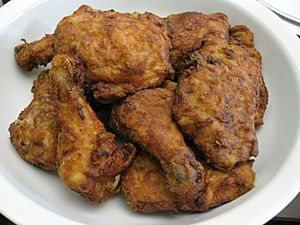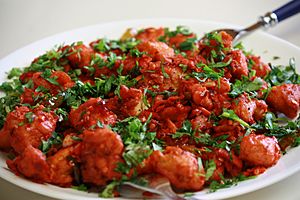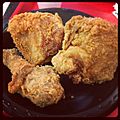Fried chicken facts for kids
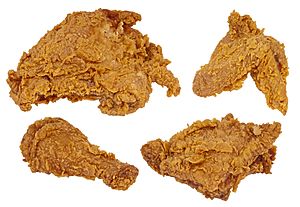
A fried chicken breast, wing, leg, and thigh
|
|
| Course | Entrée |
|---|---|
| Place of origin | United States |
| Region or state | American South |
| Serving temperature | Hot or cold |
| Main ingredients | Chicken, batter |
Fried chicken is a super yummy dish made from pieces of chicken. These chicken pieces are usually covered in a special coating, either a wet batter or dry flour, and then cooked in hot oil. This cooking makes the outside of the chicken crispy and golden brown. The chicken is often cut into parts like legs, wings, and breasts, with the bones and skin still on. You can find fried chicken at many fast food places, like KFC and Church's Chicken.
Contents
How to Make Fried Chicken
When making fried chicken, people usually don't cook a whole chicken. Instead, they cut it into smaller pieces. The front part of the chicken gives us white meat like the breast and wing. The back part gives us dark meat like the thigh and leg (also called a "drumstick").
Getting the Chicken Ready
To get the chicken pieces ready for frying, they are often coated. One way is to dip them in a wet batter, which is a mix of flour, liquid (like milk or eggs), and seasonings. Another way is to roll them in a dry coating, usually flour, to make a nice crust.
People often mix seasonings into the flour or batter to give the chicken extra flavor. Common seasonings include salt, pepper, cayenne pepper (for a little spice!), paprika, garlic powder, and onion powder. Sometimes, before coating, the chicken is soaked in milk or buttermilk to make it more tender. As the chicken cooks, its natural moisture helps the coating turn into a delicious, crispy crust.
Long ago, in 1736, a cookbook by Nathan Bailey suggested marinating chicken in lemon juice, vinegar, and spices for three hours. Then, it would be dipped in a batter made with flour, white wine, and egg yolks, and slowly fried in a deep pot of oil or butter.
Cooking Methods for Fried Chicken
Traditionally, people used lard (a type of fat) to fry chicken. Today, many different oils are used, such as corn oil, peanut oil, canola oil, or vegetable oil. Olive oil is usually not used because its flavor is too strong and it doesn't handle high heat well.
There are three main ways to fry chicken:
Pan Frying (Shallow Frying)
Pan frying uses a frying pan with some hot oil, but not enough to completely cover the chicken. The chicken pieces are coated and then placed in the hot oil. The oil is first heated very hot to quickly seal the outside of the chicken. Then, the heat is lowered to cook the chicken all the way through. Some cooks turn the chicken often, while others let it cook longer on each side. Towards the end, the heat is raised again to make the chicken extra crispy and golden brown.
Deep Frying
Deep frying means the chicken pieces are completely covered in hot oil. This is usually done in a deep fryer. The oil is heated to a very high temperature. The coated chicken pieces are put into the hot oil, and the temperature is kept steady until they are cooked perfectly.
Broasting (Pressure Frying)
Broasting is a faster way to cook fried chicken using a pressure cooker. The moisture inside the chicken turns into steam, which builds up pressure in the cooker. This allows the chicken to cook at a lower temperature but still cooks it quickly and thoroughly. The steam also helps keep the chicken moist and tender inside, while the outside stays crispy. The chicken is placed in hot oil inside the pressure cooker, and then the lid is closed to fry it under pressure.
Fried Chicken Around the World
Different countries and cultures add their own special touch to fried chicken, using various seasonings and spices. Because fried chicken is so popular, many places have created their own unique versions to suit local tastes.
North American Fried Chicken
- Barberton Chicken: Also called Serbian Fried Chicken, this style comes from Barberton, Ohio.
- Buffalo wings: These come from Buffalo, New York. Unlike most fried chicken, they are usually not battered before frying.
- Chicken fingers: Also known as chicken tenders or chicken strips, these are long pieces of chicken breast, breaded or battered, and deep-fried.
- Chicken fries: These are chicken pieces shaped like French fries, made popular by fast-food chains.
- Chicken Maryland: This is a pan-fried chicken dish, often soaked in buttermilk, served with a creamy gravy. It's from the state of Maryland.
- Chicken nuggets: Small, boneless pieces of chicken, often reformed, breaded, and fried.
- Popcorn chicken: Tiny, bite-sized pieces of boneless chicken, battered and fried, that look like popcorn.
- Chicken and waffles: A popular dish in the American South that combines fried chicken with waffles.
- Hot chicken: Common in Nashville, Tennessee, this is a spicy version of fried chicken coated with a cayenne pepper paste.
Asian Fried Chicken
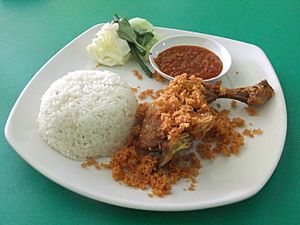
- Ayam goreng: This is a type of Indonesian, Singaporean, and Malaysian fried chicken. It's deep-fried in coconut oil and is known for its rich spices rather than a thick batter.
- Chicken 65: A deep-fried chicken dish from India.
- Crispy fried chicken: A dish from the Cantonese cuisine of China.
- Har Cheong Gai: Singaporean chicken wings fried with a special batter that includes fermented shrimp paste.
- Salt and pepper chicken: Cubes of chicken leg meat that are marinated, deep-fried, and flavored with pepper salt or five-spice powder. It's popular in Taiwanese night markets.
- Taiwan fried chicken fillet: A large piece of chicken fillet prepared similarly to salt and pepper chicken, often eaten in a paper bag.
- Chicken katsu: A Japanese deep-fried chicken cutlet coated in panko breadcrumbs.
- Korean fried chicken: Fried chicken pieces flavored with a spicy Gochujang or ganjang (soy sauce) based sauce with garlic.
- Buldak: Spicy fried or barbecued chicken with Korean seasonings.
- Sweet and sour chicken: Deep-fried balls of chicken breast in batter, served with a sweet and sour sauce.
- Toriten: Japanese tempura-style fried chicken.
- Chicken with chilies: A Sichuan-style dish from China with small deep-fried chicken pieces stir-fried with chilies.
- Chicken lollipop: An Indian snack made from fried chicken drumettes, coated in a spiced batter.
Images for kids



